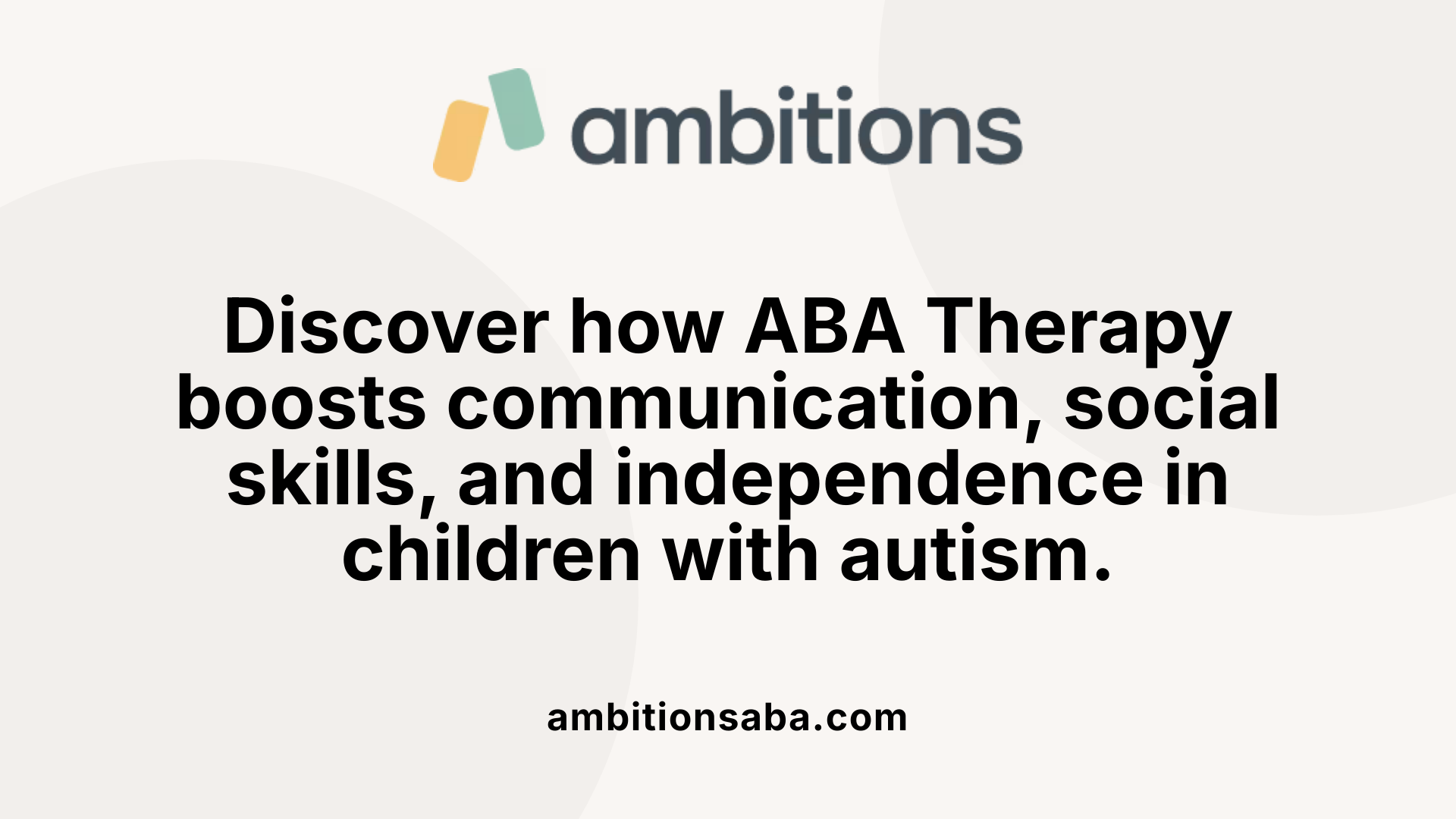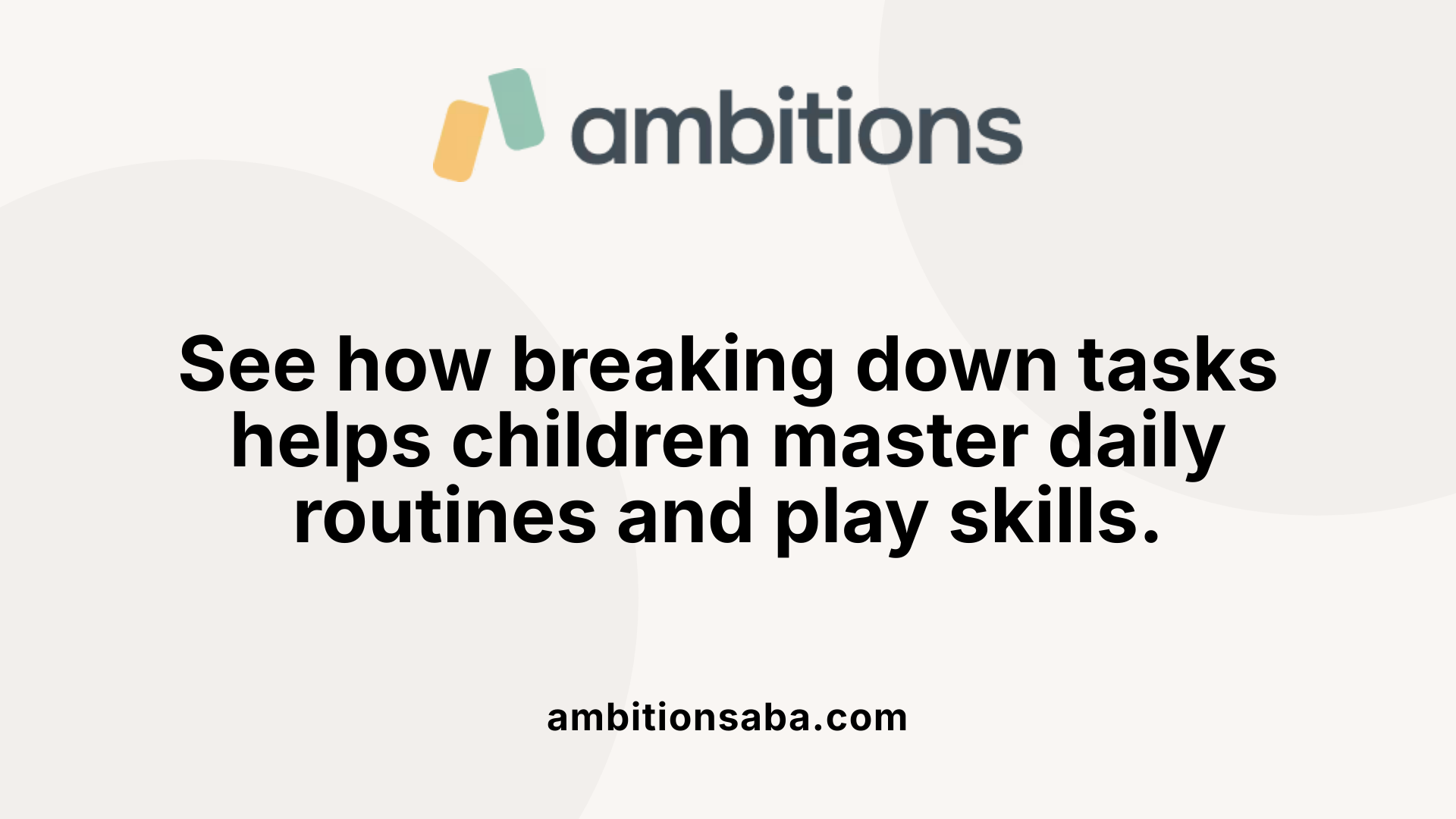Navigating Parental Burnout in the Journey of Autism Therapy
Unlocking Potential Through Structured Play and ABA
Play is more than just fun for children—it is a crucial avenue for learning and development, especially for children with autism spectrum disorder (ASD). Functional play skills, which involve using toys and objects according to their intended purpose, serve as building blocks for social, communication, and cognitive development. Applied Behavior Analysis (ABA) therapy integrates these play skills into individualized programs to promote independence and confidence. This article explores the nature of functional play, its role in ABA therapy, and evidence-based strategies to nurture these skills in children with autism.
Understanding Applied Behavior Analysis (ABA) Therapy and Its Role in Autism Support

What is Applied Behavior Analysis (ABA) therapy, and how does it help individuals with autism?
Applied Behavior Analysis (ABA) therapy is a well-established treatment approach primarily used for children with autism spectrum disorder. It focuses on improving socially important behaviors by applying scientific learning principles. Essentially, ABA uses positive reinforcement to encourage desired behaviors, helping children develop vital skills.
ABA is personalized to each child's unique needs and abilities. Therapists begin with thorough assessments that examine communication, social interaction, self-help, play, motor skills, and academic abilities. With this information, they develop individualized plans targeting meaningful skill areas.
How does ABA impact key skill areas?
ABA therapy enhances a wide range of skills. Communication and social interaction improve as children learn to engage more effectively with others. Daily living skills, also called activities of daily living (ADLs), like brushing teeth and dressing, are broken down into manageable steps through task analysis. This method reduces overwhelm and builds confidence.
Academic skills are also addressed consistently, fostering progress in learning and classroom readiness. The structure and consistency of ABA, along with ongoing measurement and reinforcement, support steady gains across these domains.
Overall, ABA helps children with autism become more independent and better able to navigate everyday environments. Early intervention with ABA has been linked to significant improvements in language, social competence, and adaptive functioning, paving the way for fuller community participation and quality of life.
Who Delivers ABA Therapy and How Family Involvement Supports Progress

Who typically provides ABA therapy for individuals with autism?
ABA therapy is primarily delivered by professionals certified in behavioral analysis. These experts include Board Certified Behavior Analysts (BCBAs), Board Certified Assistant Behavior Analysts (BCaBAs), Qualified Behavioral Analyst Practitioners (QBA), and Registered Behavior Technicians (RBTs). These certifications ensure that providers have the specialized knowledge and skills to design and implement effective behavior interventions tailored to each child's needs.
Types of providers and specialized clinics
ABA services can be accessed through various settings such as specialized clinics, private practices, and sometimes school-based programs. Accredited organizations, recognized by groups like the Behavior Analyst Certification Board (BACB) and the Behavioral Health Center of Excellence (BHCOE), uphold rigorous standards, affirming the quality and safety of care provided. This accreditation offers families confidence in the professionalism and effectiveness of the therapy.
Insurance coverage and access
Access to ABA therapy often requires a confirmed diagnosis from a licensed physician or psychologist. Most health insurance plans, including Medicaid in many states, offer coverage for ABA services, although specifics may vary. Families typically work with providers to understand their coverage and navigate authorization processes to secure consistent therapy.
Family involvement and training
Family participation is a cornerstone of ABA therapy. Providers emphasize training parents and caregivers to reinforce new skills and behavior strategies outside of therapy sessions. This collaborative approach enhances the child's progress by promoting consistency and generalization of skills in daily life. Additionally, engaging families through parent-child play and other supportive activities strengthens bonds and amplifies therapeutic outcomes.
By combining expert care with active family engagement, ABA therapy creates a supportive environment that optimizes a child's development and independence.
Core Goals and Evidence-Based Techniques in ABA for Autism

What are the common goals and techniques used in ABA therapy for autism?
ABA therapy focuses on improving communication, social skills, independence, and reducing challenging behaviors. Goals are individualized and measurable, tailored to each child's unique developmental needs and preferences. This personalized approach ensures that therapy targets meaningful, everyday skills that enhance quality of life.
Individualized Goals for Growth and Independence
Therapists begin with thorough assessments of a child's existing abilities in areas such as communication, social interaction, self-help, play, motor, and academic skills. From this foundation, they design targeted objectives that help the child gain independence in daily activities like dressing, brushing teeth, or handwashing.
Techniques That Guide Learning
ABA employs methods like task analysis, which breaks complex skills into manageable, sequential steps. This technique uses chaining—either forward or backward—to teach routines step-by-step according to the child’s learning style. Positive reinforcement encourages desired behaviors by offering rewards or praise, increasing the likelihood of repeat behaviors.
Prompting strategies support skill acquisition by guiding the child gently until they can perform independently. Techniques such as shaping and fading gradually modify and fade prompts, promoting steady progress.
Data-Driven and Collaborative Approach
Continuous data collection tracks skill mastery and behavior changes, informing necessary adjustments. The use of SMART (Specific, Measurable, Achievable, Relevant, Time-bound) goals ensures progress is clear and objective. Collaboration among therapists, families, and educators strengthens consistency and relevance, allowing skills to generalize to real-world settings.
In summary, ABA integrates structured, scientifically supported interventions, broken down into personalized steps, to foster communication, social connection, and independence for children with autism.
The Role of Task Analysis in Building Functional Play and Daily Living Skills

What is Task Analysis and Its Purpose in ABA Therapy?
Task analysis is a technique used in Applied Behavior Analysis (ABA) therapy that breaks down complex tasks into small, manageable steps. This method helps children with autism learn and master skills by focusing on one part of an activity at a time. The main goal is to promote independence in daily life and improve functional play abilities.
How are Complex Activities Broken Down?
In practice, tasks are divided into sequential steps tailored to each child's unique needs and abilities. For example, an activity like brushing teeth might be separated into steps such as picking up the toothbrush, applying toothpaste, brushing each section of teeth, rinsing, and putting the toothbrush away. This breakdown reduces overwhelm and builds confidence during learning.
What Are Forward and Backward Chaining?
Task analysis often uses chaining techniques to teach these steps. Forward chaining means teaching steps in order, starting with the first step and moving forward. Backward chaining teaches the last step first and works backward. Therapists choose the chaining method best suited to the child’s learning style and capacity.
How is Task Analysis Tailored to Individual Abilities?
Each child’s skills, preferences, and goals are assessed at the start. From there, task analysis is customized to meet their developmental level, ensuring the instruction is consistent and systematic. Visual supports like cards or objects are commonly used to assist learning, making complex tasks easier to understand.
How Does Task Analysis Support Daily Living Skills?
This technique is especially important for teaching activities of daily living (ADLs) such as dressing, washing hands, and dental hygiene. By mastering these tasks, children with autism gain valuable independence. Task analysis allows them to acquire critical life skills step-by-step, contributing to their overall confidence and self-sufficiency.
Integrating Visual Supports to Enhance Learning and Engagement

What Are Visual Support Tools in ABA Therapy?
Visual support tools include items like cards, replicas, and objects that serve as concrete references to aid learning. These aids help children with autism see and understand what they need to do, turning abstract concepts into clear, manageable information.
How Do Cards, Replicas, and Objects Help?
Cards might show pictures or steps of a task, while replicas or real objects allow hands-on engagement. For example, a replica toothbrush may be used alongside a card showing the steps for brushing teeth, reinforcing learning through multiple sensory channels.
Benefits for Reducing Overwhelm
Breaking information down with visual tools simplifies complex tasks, reducing anxiety and overwhelm. Children can process one step at a time, building confidence as they master each part before moving on.
Supporting Communication and Comprehension
Visual supports also enhance communication by providing visual cues for requests, emotions, and actions. They help children understand expectations and follow instructions more easily, encouraging independence and reducing frustration.
Application in Play and Daily Tasks
In both play and daily living activities, visual supports guide the child through sequences—such as setting the table or playing a board game. This structured approach makes learning fun, accessible, and suited to each child's unique needs.
Functional Play: Definition and Significance in Development
What is functional play?
Functional play involves using toys or objects in ways that match their intended purposes. For instance, a child rolling a ball or pretending to feed a doll exemplifies functional play. This type of play is accessible and natural, allowing children to engage meaningfully with their environment.
Examples of functional play
Common activities include rolling a ball across the floor, pushing a toy car, or using a doll to simulate feeding or dressing. These actions encourage children to explore how objects work and interact with the world around them.
How functional play aids problem-solving and understanding of object properties
Through functional play, children discover the properties and effects of different actions on objects. For example, rolling a ball demonstrates cause-and-effect, while feeding a doll helps a child understand sequences and routines. This exploration supports cognitive development by enhancing problem-solving skills and helping children make sense of their surroundings.
Fostering social interaction and connectedness
Functional play often involves social elements, inviting children to share toys or participate in joint activities. Engaging with peers or caregivers through such play fosters connectedness and helps develop social skills like turn-taking, communication, and cooperation.
Global developmental benefits
Beyond cognitive and social growth, functional play supports overall development. It encourages fine and gross motor skills, language acquisition, and emotional understanding. Through meaningful, hands-on experiences, functional play creates a foundation for children to thrive in multiple developmental areas.
Strategies to Support and Build Functional Play Skills
Environment setup
Creating a supportive play environment is crucial to building functional play skills. This means organizing the play area to be safe, accessible, and stocked with a variety of age-appropriate toys and materials that invite exploration and engagement.
Engaging child's interests
Tapping into a child's existing interests can motivate participation in play. By selecting toys and activities that the child naturally enjoys, therapists and caregivers can foster enthusiasm and encourage deeper interaction with play materials.
Modeling and imitation
Demonstrating play behaviors provides a clear example for children to observe and imitate. Caregivers and therapists can model how to use toys functionally, such as rolling a ball or feeding a doll, which supports learning through copying and repetition.
Introducing new toys and sensory experiences gradually
To prevent overwhelm, new play items and sensory inputs are introduced slowly and thoughtfully. This gentle approach helps children feel comfortable while expanding their play repertoire and sensory tolerance.
Encouraging social interaction and communication
Functional play often involves social elements that promote communication skills. Structured play activities encourage turn-taking, sharing, and engagement, providing opportunities for children to practice verbal and nonverbal communication like requesting, pointing, and gesturing.
These strategies collectively nurture children’s functional play abilities, which support problem-solving, language development, social connections, and independence.
Examples of Activities Promoting Functional Play Across Skill Domains
Using Cars and Trains
Playing with cars and trains offers children multiple avenues to practice communication skills and develop fine and gross motor abilities. Activities like narrating play actions, building train tracks, and engaging in role-play scenarios help strengthen language use and imaginative thinking. These play sessions also support social-emotional growth as children cooperate and share during interactive play.
Fine and Gross Motor Skills Development
Manipulating play items such as blocks, Legos, and toy vehicles fosters precise hand movements (fine motor) and larger body coordination (gross motor). For instance, building a complex Lego structure enhances dexterity and pattern recognition, while pushing a train along a track encourages whole-body movement and spatial awareness.
Communication and Social-Emotional Development
Functional play encourages children to request items, express emotions, and interact socially. Activities like turn-taking during board games or collaboratively creating stories using dolls or blocks promote conversational skills, empathy, and emotional understanding. These social experiences boost confidence and support children in navigating various social interactions.
Role-playing and Storytelling
Toys like baby dolls and dollhouses facilitate symbolic and relational play by allowing children to explore different roles, routines, and social situations. Storytelling through picture books, combined with commenting on events and emotions, enriches language comprehension and cognitive abilities while encouraging imagination.
Incorporating Toys Such as Blocks, Legos, and Dolls
Blocks and Legos not only support motor skills but also cognitive development through understanding cause-and-effect and engaging in pattern recognition. Expanding play scenarios challenge children to use problem-solving skills. Baby dolls enhance social understanding by promoting empathy and emotional expression, helping children grasp everyday routines and relationships.
These play activities foster a broad range of skills essential for children with autism, blending enjoyment with developmental growth and social connection.
Play-Based ABA Therapy: Motivating Learning and Generalizing Skills
Tailoring Play-Based Strategies to Individual Needs
At All Points ABA, therapy is highly personalized to suit each child's unique interests and developmental goals. Techniques such as board games, imaginative play, building activities, and outdoor exploration are carefully chosen to engage children effectively and support their learning.
Use of Board Games, Imaginative and Outdoor Play
Structured activities like board games teach turn-taking and problem-solving. Imaginative play encourages creativity and symbolic thinking, while outdoor activities help develop gross motor skills and social interaction in natural settings.
Increasing Motivation and Engagement
Play-based ABA therapy transforms learning into an enjoyable experience. When activities align with a child's preferences, motivation naturally increases, leading to better participation and sustained attention during sessions.
Supporting Generalization and Independence
By embedding learning in play, skills practiced during therapy are more easily transferred to everyday life. Children gain confidence and independence as they apply social, communication, and self-help skills in various real-world contexts.
Strengthening Parent-Child Bonds Through Play
Involving families in play sessions enhances therapy outcomes by promoting consistent practice at home. Shared play strengthens emotional connections, providing a supportive environment that reinforces newly acquired behaviors and skills.
Measuring Success: Consistency, Individualization, and Systematic Instruction in ABA
Why is systematic instruction important in ABA therapy?
Systematic instruction provides a structured, step-by-step teaching process that helps children with autism learn skills effectively. By carefully sequencing lessons and breaking tasks into manageable parts, therapists can ensure that children understand each component before moving on. This approach supports mastery and reduces confusion, laying a solid foundation for building more complex skills.
How does consistency influence the effectiveness of teaching?
Consistency in teaching approaches means using similar methods, schedules, and communication styles across therapy sessions. This predictable environment helps children feel secure and focused, promoting better learning. When all caregivers and therapists apply consistent strategies, children are more likely to respond positively and generalize skills beyond therapy settings.
What role does individualization play in ABA interventions?
Individualizing interventions ensures that the therapy fits the unique strengths, needs, and preferences of each child. By tailoring task analyses and play activities, therapists address specific goals that matter most to the child and family. Customized teaching not only improves engagement but also accelerates progress by targeting meaningful and relevant skills.
How are data-driven decisions used in the process?
Data collection is an integral part of ABA therapy, guiding decisions about when to introduce new skills or modify approaches. Therapists monitor progress regularly, using objective metrics to identify what is working and what needs adjustment. This responsive process maximizes treatment efficiency and helps maintain focus on achieving real-world outcomes.
How do these approaches ensure meaningful and lasting skill acquisition?
Combining systematic instruction, consistency, and individualization creates an effective learning environment that supports gradual skill building. By using structured yet flexible methods, children gain confidence and independence. These techniques reduce overwhelm, encourage active participation, and help skills transfer to everyday life, ensuring that gains are both meaningful and durable.
Cultivating Lifelong Skills Through Functional Play and ABA
Functional play skills represent a cornerstone in the developmental journey of children with autism, serving as essential pathways to communication, social interaction, and everyday independence. Applied Behavior Analysis therapy, with its scientific foundation and individualized approach, leverages task analysis, visual supports, and playful engagement to nurture these skills effectively. By incorporating structured and meaningful play activities tailored to each child's interests and abilities, therapists and families can motivate learning, foster resilience, and empower children to thrive within their environments. Ultimately, building functional play skills through ABA not only enhances developmental outcomes but also enriches quality of life and social connection, paving the way for greater independence and fulfillment.
References
- Task Analysis in ABA Therapy: Strategies and Examples
- Understanding the Role of Play in ABA Therapy
- Functional Play
- Applied Behavior Analysis (ABA)
- The Top 10 Reasons Children With Autism Deserve ABA
- Applied Behavior Analysis (ABA)
- 6 Benefits of ABA Therapy for Children with Autism
- Riverside Clinic - Autism Treatment
- Behavioral Health Treatment | Children with Autism Spectrum ...
- ABA Therapy Providers Directory

